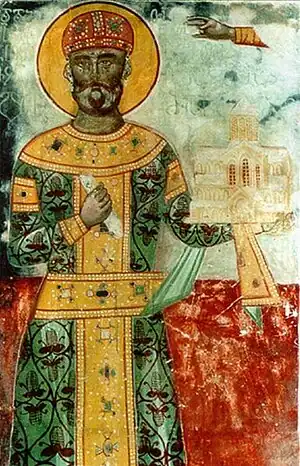| Battle of Ertsukhi | |||||||
|---|---|---|---|---|---|---|---|
| Part of the Georgian-Seljuk wars | |||||||
| |||||||
| Belligerents | |||||||
|
| |||||||
| Commanders and leaders | |||||||
| David IV | Manuchihr ibn Shavur | ||||||
The Battle of Ertsukhi was fought in 1104 between the armies of the Kingdom of Georgia and the Seljuk Empire in southeastern part of Georgia, near Ertsukhi.
Background
Prior to David IV's reign, the Kingdom of Georgia was confronted by several major threats. The country was invaded by the Seljuq Turks, which were part of the same wave which had overrun Anatolia, defeating the Byzantine Empire and taking captive the emperor Romanos IV Diogenes at the battle of Manzikert in 1071.[1] In what the medieval Georgian chronicle refers to as didi turkoba, "the Great Turkish Invasion", several provinces of Georgia became depopulated and King George II was forced to sue for peace, becoming a tributary of Seljuk sultan Malik-Shah I in 1083. The great noble houses of Georgia, capitalizing on the vacillating character of the king, sought to assert more autonomy for themselves; Tbilisi, the ancient capital of Kartli, remained in the hands of the Emirate of Tbilisi, and a local dynasty, for a time suppressed by George's father Bagrat IV, maintained its precarious independence as the Kingdom of Kakheti-Hereti in the eastern region of Kakheti under the Seljuq suzerainty.[2][3]
Battle
In the 1104, the Georgian king David IV was able to exploit internal unrest and distraction with the Crusades in the Seljuq Empire and successfully campaigned against Seljuk vassal state Kakheti-Hereti, finally turning it into one of his duchies. The king of Kakheti-Hereti, Aghsartan II of Kakheti, was captured by the Georgian nobles Baramisdze and Arshiani and was imprisoned in Kutaisi.[4]
The Seljuk Sultan Berkyaruq sent a large army to Georgia to retake Kakheti-Hereti. The battle was fought in southeastern part of the Kingdom, near the Ertsukhi. King David of Georgia personally took part in the battle, where the Seljuks were decisively defeated.
Folklore
According to a legendary tradition described in The Georgian Chronicles, when David removed his armor after the battle, blood splashed down from behind his armor plate. This led the by-standers to believe that their king was wounded, when in fact the blood belonged to the enemies that the king had slain in battle.[4][5]
Notes
- ↑ Rapp 2000, p. 572.
- ↑ Toumanoff 1966, p. 624.
- ↑ Rayfield 2012, p. 80.
- 1 2 Rayfield 2012, p. 86.
- ↑ Kartlis Tshovreba, p. 346.
References
- "Kartlis Tskhovreba". The Georgian Chronicles Chapter 6 (PDF) (in Georgian). p. 346. Archived from the original (PDF) on 2015-02-04.
- Rapp, Stephan (2000). "Sumbat Davitʿis-dze and the Vocabulary of Political Authority in the Era of Georgian Unification". Journal of the American Oriental Society. 120 (4): 570–576. doi:10.2307/606617. JSTOR 606617.
- Rayfield, Donald (2012). Edge of Empires (Kindle ed.). Reaktion Books. ISBN 978-1780230306.
- Toumanoff, Cyril (1966). "Armenia and Georgia". The Cambridge Medieval History (Volume 4). Cambridge University Press. pp. 593–637.
